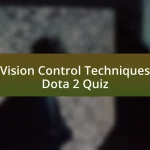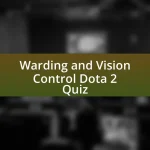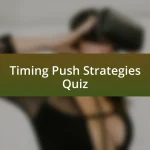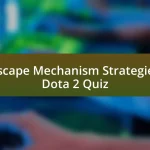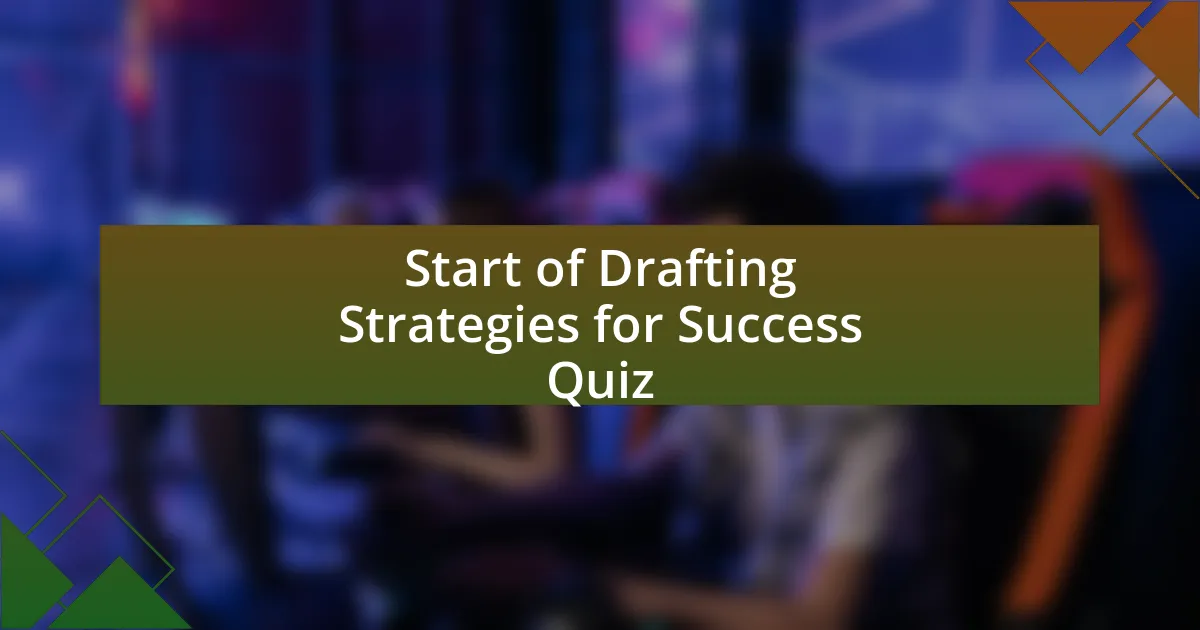
Start of Drafting Strategies for Success Quiz
1. What is the significance of a balanced draft composition in Dota 2?
- It avoids using any support heroes.
- It focuses solely on damage output.
- It ensures team roles are complementary.
- It guarantees all heroes are melee.
2. How does a team`s synergy influence drafting strategies in Dota 2?
- It emphasizes winning through random choice selection.
- It determines the monetary value of each hero picked.
- It shapes the selection of heroes based on team roles.
- It focuses solely on individual player performance.
3. What role does map control play in Dota 2 drafting decisions?
- It focuses solely on hero abilities during the match.
- It determines the winning team before the game starts.
- It refers to the amount of gold each hero has at the start.
- It helps teams secure advantageous positions on the map.
4. How important is it to counter the enemy`s picks during the draft phase in Dota 2?
- It is very important to counter the enemy`s picks.
- It is better to ignore enemy picks completely.
- It is not necessary to consider enemy picks.
- It is somewhat irrelevant to counter their picks.
5. What are some common roles to prioritize in a Dota 2 draft?
- Tank, DPS, Healer
- Midlane, Carry, Jungle
- Core, Offlane, Support
- Mage, Marksman, Assassin
6. How can flexibility in hero picks impact the outcome of a Dota 2 match?
- Flexibility restricts the variety of hero selections in matches.
- Flexibility allows teams to counter opponent strategies effectively.
- Flexibility results in lower team coordination and communication.
- Flexibility leads to more predictable gameplay overall.
7. Why is it important to consider the late game potential during drafting in Dota 2?
- To focus only on hero abilities.
- To secure advantageous team fights later on.
- To reduce the game`s duration significantly.
- To increase the number of kills in the early game.
8. What is the concept of `first pick` advantage in Dota 2 drafts?
- The team that picks first has the advantage of choosing the most powerful heroes.
- The team that picks first gets to ban more heroes.
- The team that picks second has a higher win rate.
- The team that picks second gets to choose unique items.
9. How do team compositions differ between drafts for public matches versus professional Dota 2?
- Public matches allow only popular heroes to be selected.
- Professional drafts are more strategic and balanced.
- Professional drafts focus on flashy abilities and showmanship.
- Public matches prioritize random picks and simplicity.
10. What is the impact of meta shifts on drafting strategies in Dota 2?
- Meta shifts can change hero priority and flexibility in drafting.
- Meta shifts make all heroes equally viable in drafting.
- Meta shifts are only relevant during gameplay, not in drafting.
- Meta shifts have no effect on team communication during drafting.
11. How does banning potential game-changing heroes affect Dota 2 drafting?
- It guarantees more powerful heroes in every game.
- It allows for endless combinations without rules.
- It limits options, encouraging strategic picks.
- It eliminates any risk during the draft phase.
12. What are some examples of high-impact heroes commonly drafted in Dota 2?
- Omniknight
- Crystal Maiden
- Tinker
- Faceless Void
13. Why is communication crucial during the drafting phase in a Dota 2 match?
- To engage all team members effectively.
- To randomly select heroes without strategy.
- To confuse the opposing team players.
- To secure the best items in the shop.
14. What strategies can be employed to draft successfully against a team with a strong early game?
- Prioritize aggressive ganks early on
- Pick champions with weak late-game scaling
- Invest heavily in early game items
- Focus on scaling later in the game
15. How do counter-picking strategies function in Dota 2 drafts?
- Counter-picking involves banning the most popular heroes in the game.
- Counter-picking allows teams to select heroes that can exploit the weaknesses of their opponents` draft.
- Counter-picking is simply selecting the strongest heroes regardless of the opponent`s choices.
- Counter-picking focuses on picking heroes that synergize well with your own team`s composition.
16. Why is it vital to draft support heroes that complement the core heroes in Dota 2?
- To reduce the need for strategic planning.
- To make the game more visually appealing.
- To maximize synergy and team effectiveness.
- To allow for more aggressive early game plays.
17. How does understanding hero abilities influence the drafting process in Dota 2?
- It makes hero selection irrelevant to the match outcome.
- It allows players to choose any hero regardless of team needs.
- It helps to counter opponents` strengths and synergize team composition.
- It determines the winning team without any skill assessment.
18. What are the common pitfalls in drafting during a Dota 2 match?
- Ignoring team synergy
- Using excessive jargon
- Avoiding unnecessary clutter
- Always following a rigid format
19. How can experimenting with unconventional hero combinations succeed in Dota 2 drafting?
- It always ensures a perfectly balanced team composition.
- It leads to guaranteed victories in every match.
- It can surprise opponents and create unpredictable scenarios.
- It eliminates the need for strategy and teamwork.
20. What is the significance of the hero pool depth in Dota 2 drafting?
- It allows for diverse strategies and counters.
- It has no impact on drafting decisions.
- It simplifies the game mechanics significantly.
- It limits hero selection for teams.
21. How can leaving certain heroes unbanned strategically benefit a Dota 2 draft?
- It allows for counter-picking opponents effectively.
- It guarantees a win in every game.
- It ensures no strategies can be used against you.
- It eliminates the need for team coordination.
22. What is the importance of scouting opponents` previous drafts in Dota 2?
- It is irrelevant and has no impact on the game.
- It allows teams to prepare strategies against enemy picks.
- It only matters during the last minutes of the match.
- It helps in improving players` individual skills.
23. How do timings and pacing influence picks and bans in Dota 2 drafts?
- Timing and pacing determine hero priorities and counter-picks.
- Timings dictate the speed at which players can level up.
- Pacing influences the physical location of the heroes on the map.
- Timings only affect the visual aesthetics of the game.
24. What drafting strategies can mitigate a losing streak in Dota 2?
- Ignoring team composition when drafting
- Choosing heroes without considering synergy
- Adjusting hero picks based on opponent trends
- Always picking the same hero every game
25. How does player comfort with heroes impact Dota 2 draft choices?
- It allows players to choose any hero regardless of composition.
- It encourages players to ignore their strengths and focus only on counters.
- It leads to better synergy and coordination among team members.
- It makes every player play the same heroes to reduce confusion.
26. What factors should be considered for team fight compositions in Dota 2 drafting?
- The color of the map
- Game graphics and sound design
- Heroes` synergy and roles
- Player’s internet speed
27. How can tempo-control heroes shape a Dota 2 match during the draft phase?
- They focus solely on character skins and cosmetics.
- They draft always aggressive heroes for dominance.
- They can dictate the pace of the game with pick strategies.
- They confuse enemies by selecting rare heroes.
28. Why are team-specific strategies relevant for Dota 2 drafts?
- They help in tailoring the team`s composition and playstyle.
- They are only relevant for individual player skill.
- They have no impact on team performance.
- They are only important for casual games.
29. What role does adaptability play in effective Dota 2 drafting?
- It focuses on picking heroes with the highest base stats.
- It ensures all players understand the game lore completely.
- It prevents players from changing their roles during the game.
- It allows teams to respond to enemy picks and counter strategies effectively.
30. How does the element of surprise contribute to drafting strategies in Dota 2?
- It makes drafting less strategic than before.
- It has no impact on game dynamics.
- It can lead to unexpected picks and counter-picks.
- It always results in predictable outcomes.
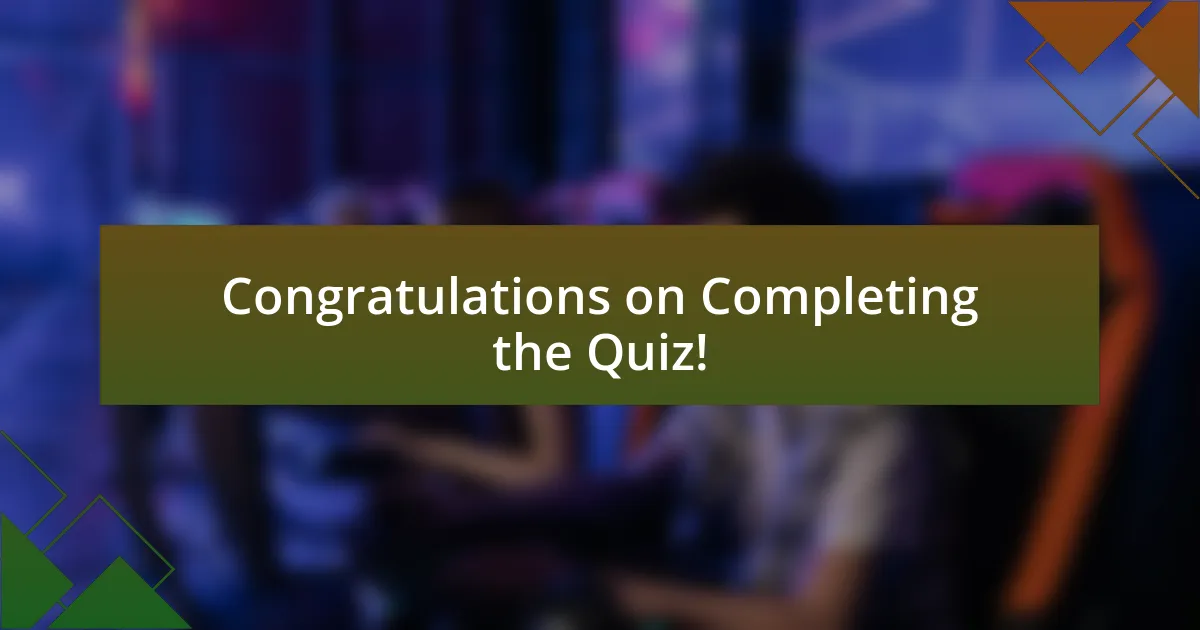
Congratulations on Completing the Quiz!
You’ve successfully completed the quiz on ‘Drafting Strategies for Success.’ We hope you found the experience enjoyable and insightful. Engaging with these questions has likely provided you with a deeper understanding of effective drafting techniques. Whether you uncovered new strategies or reinforced your existing knowledge, each insight is a step towards becoming a more skilled drafter.
Throughout the quiz, you may have learned about important elements such as clarity, organization, and audience awareness in drafting. These strategies are crucial for effective communication. Mastering them empowers you to convey your ideas clearly and persuasively. The ability to draft well can significantly influence your success in various fields, from business to academic writing.
If you’re eager to expand your knowledge further, we invite you to explore the next section on this page. There, you will find a rich array of resources on ‘Drafting Strategies for Success.’ Delve deeper into techniques and tips that can enhance your drafting skills. Embrace the opportunity to learn and grow in this essential area!

Drafting Strategies for Success
Understanding the Fundamentals of Drafting Strategies
Drafting strategies refer to planned approaches for creating legal or business documents. These strategies ensure clarity, consistency, and effectiveness in communication. A strong foundation includes understanding the purpose of the document, the target audience, and key legal principles that may apply. Mastering these fundamentals enhances the quality and impact of the drafted materials. Effective drafting reduces the risk of misinterpretation or legal disputes.
Types of Drafting Strategies
Different drafting strategies apply based on the document type. Common strategies include persuasive drafting, descriptive drafting, and analytical drafting. Persuasive drafting aims to convince readers of a specific viewpoint. Descriptive drafting provides factual information clearly and concisely. Analytical drafting evaluates complex information, often used in legal and policy contexts. Recognizing the appropriate strategy for the document type enhances its effectiveness.
Structuring a Draft for Coherence
The structure of a draft significantly impacts its coherence and readability. A well-structured draft includes an introduction, body, and conclusion. Each section must logically flow into the next, with clear transitions. Using headings and subheadings helps organize content. Bullet points or numbered lists can clarify complex information. Employing a consistent format enhances professionalism and aids reader navigation.
Incorporating Feedback into Drafting Strategies
Feedback is essential for refining drafting strategies. Soliciting opinions from colleagues or stakeholders can identify areas for improvement. Constructive feedback highlights unclear sections or misleading arguments. Integrating this feedback strengthens the draft’s overall quality. Revision processes should focus on clarity, relevance, and conciseness. Continuous improvement based on feedback leads to more effective documents.
Utilizing Technology in Drafting Strategies
Technology plays a crucial role in modern drafting strategies. Tools such as word processors, grammar checkers, and specialized drafting software enhance accuracy and efficiency. These tools can automate formatting and ensure adherence to style guidelines. Collaboration platforms allow multiple users to edit and review drafts simultaneously. Leveraging technology improves productivity and reduces errors during the drafting process.
What are drafting strategies for success?
Drafting strategies for success are systematic approaches used during the drafting process to enhance the quality and effectiveness of written work. These strategies include outlining, peer reviews, and iterative revisions. Studies have shown that structured outlines can significantly improve coherence in writing, leading to more impactful communication.
How can one implement effective drafting strategies?
Effective drafting strategies can be implemented by first creating a detailed outline that maps out the key ideas and structure of the document. Following this, one should engage in multiple drafts, utilizing feedback from peers to refine the content. Research indicates that incorporating diverse perspectives during peer review can enhance clarity and persuasion in writing.
Where can one find resources on drafting strategies?
Resources on drafting strategies can be found in educational institutions, writing centers, and online platforms dedicated to writing skills. Websites like Purdue OWL provide comprehensive guides on various drafting techniques. Additionally, books on technical writing often include chapters specifically addressing effective drafting strategies.
When is the best time to start applying drafting strategies?
The best time to start applying drafting strategies is during the initial planning phase of any writing project. By incorporating these strategies early on, writers can establish a strong foundation for their work. A study from the National Council of Teachers of English supports the notion that earlier drafting leads to higher quality final products.
Who can benefit from drafting strategies for success?
Anyone involved in writing, including students, professionals, and researchers, can benefit from drafting strategies for success. These strategies improve clarity, coherence, and overall quality in diverse writing contexts. According to a survey by the Council of Writing Program Administrators, 85% of writing instructors believe that strategic drafting significantly enhances student writing skills.



